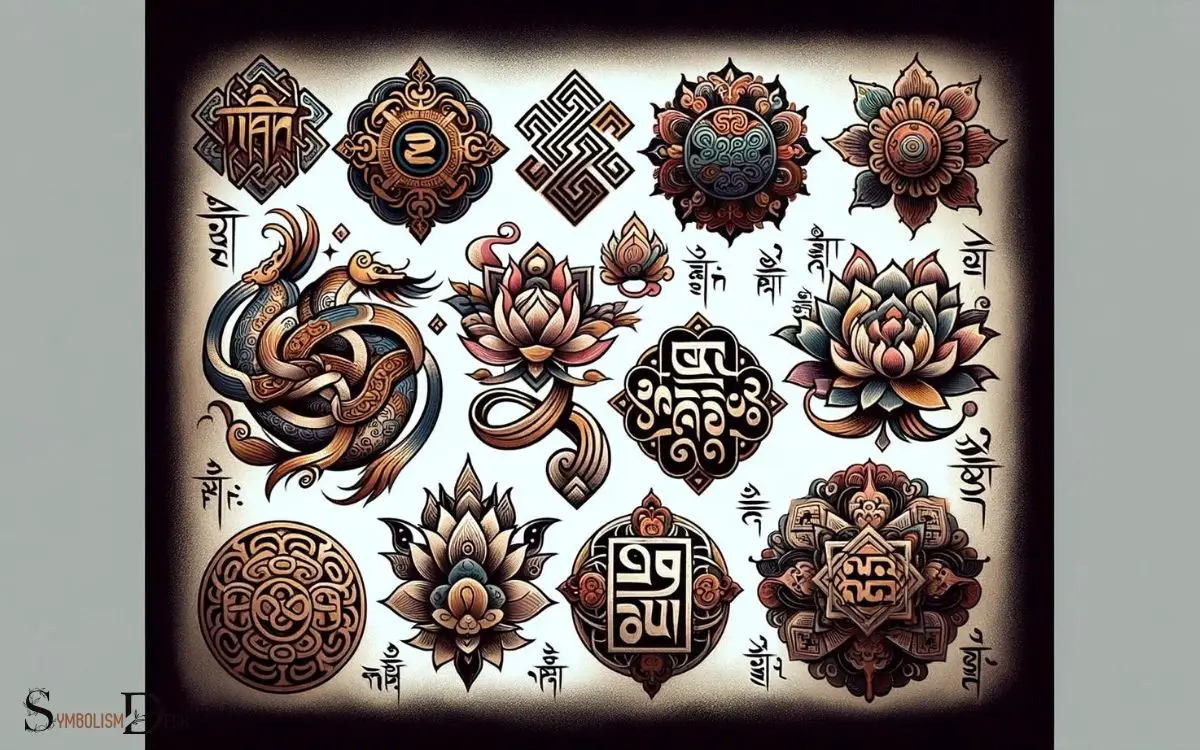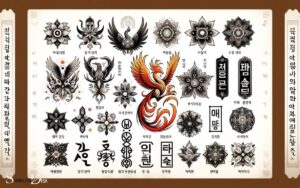Tibetan Symbol Tattoos and Meanings: Explain!
Tibetan symbol tattoos are revered for embodying the essence of Tibetan culture, imbued with profound meanings and spiritual connotations.
These tattoos serve as more than mere adornments; they are a testament to one’s connection with the wisdom and traditions of Tibetan heritage.
Popular among those who value spiritual depth and cultural richness in body art, Tibetan tattoos offer a diverse range of symbols, each with its own unique story and significance.
Tibetan symbol tattoos represent various aspects of life, spirituality, and the universe according to Tibetan beliefs. For example, the Endless Knot (Srivatsa) symbolizes the interconnectedness of all things and the cyclicality of life.
The Lotus Flower stands for purity and spiritual awakening. The Wheel of Dharma (Dharmachakra) represents the teachings of Buddha and the path to enlightenment.
These symbols are deeply ingrained in the Tibetan way of life and are often chosen as tattoos to reflect personal beliefs, aspirations, and a connection to Tibetan spiritual philosophy.
Embrace the sacred art of Tibetan tattoos, where each intricate design is a silent ode to an ancient culture’s wisdom.

Key Takeaway
The History of Tibetan Symbols
Tibetan symbols have a rich history that dates back centuries and encompasses a wide range of cultural and spiritual significance.
These symbols originated in ancient Tibet and were deeply intertwined with Tibetan Buddhism, Bon, and the region’s indigenous spiritual beliefs.
They were used in religious rituals, art, and everyday life. The symbols often represented deities, mantras, or sacred objects, serving as visual expressions of profound philosophical concepts.
Over time, these symbols became an integral part of Tibetan culture, influencing art, architecture, and literature.
As Tibet interacted with neighboring regions, such as India, China, and Nepal, the symbols also absorbed elements from these cultures, enriching their meanings.
Today, Tibetan symbols continue to captivate people worldwide, embodying a timeless wisdom and spiritual depth that transcends geographical boundaries.
Cultural Significance and Meanings
With a history deeply intertwined with Tibetan Buddhism, Bon, and indigenous spiritual beliefs, Tibetan symbols continue to hold immense cultural significance and convey profound meanings.
These symbols are rich with cultural heritage and carry deep spiritual and philosophical significance for the Tibetan people.
Some of the key cultural meanings associated with Tibetan symbols include:
- Spiritual Connection: Many Tibetan symbols are deeply connected to spiritual beliefs and practices, representing concepts such as enlightenment, compassion, and the interconnectedness of all beings.
- Protection and Blessings: Tibetan symbols are often seen as sources of protection and blessings, with individuals seeking to incorporate them into their lives to ward off negative energies and attract positive forces.
- Cultural Identity: These symbols serve as a powerful expression of Tibetan cultural identity, preserving ancient traditions and beliefs while also serving as a means of connection and solidarity within the community.
Traditional Tibetan Symbolism
How are traditional Tibetan symbols utilized in contemporary tattoo designs, and what are their significant meanings?
Traditional Tibetan symbols carry deep spiritual and cultural significance, making them popular choices for tattoo designs.
The most common traditional Tibetan symbols used in tattoos include the endless knot, the double dorje, the lotus flower, and the Tibetan om.
The endless knot symbolizes the interconnectedness of all things and the infinite wisdom of the Buddha.
The double dorje represents the indestructibility of diamond-like clarity in Buddhism. The lotus flower symbolizes purity, enlightenment, and the ability to rise above obstacles.
The Tibetan om, or ‘Aum,’ represents the essence of the universe and the unity of body, speech, and mind.
Each of these traditional Tibetan symbols holds profound meaning and is often incorporated into contemporary tattoo designs to convey spiritual and cultural significance.
Modern Interpretations in Tattoo Art
Contemporary tattoo artists have creatively reinterpreted traditional Tibetan symbols, infusing them with modern aesthetics and personal meanings.
This fusion of old and new has resulted in a vibrant array of tattoo designs that resonate with individuals on a deeply personal level.
Some of the modern interpretations of Tibetan symbols in tattoo art include:
- Geometric Patterns: Artists often incorporate traditional Tibetan symbols into geometric patterns, adding a contemporary twist to the design.
- Watercolor Techniques: Utilizing watercolor techniques, tattoo artists infuse Tibetan symbols with a spectrum of colors, giving the tattoos a modern and artistic flair.
- Minimalist Approach: Some individuals opt for minimalist designs, simplifying traditional Tibetan symbols to create subtle yet impactful tattoos.
These modern interpretations reflect the evolving nature of tattoo art, where ancient symbolism meets contemporary expression.
This evolution of Tibetan symbols in modern tattoo art seamlessly transitions into the subsequent section about ‘common Tibetan symbols in tattoos’.
Common Tibetan Symbols in Tattoos
Tibetan symbols hold deep meaning and significance in tattoo art. The lotus, representing purity and spiritual awakening, is a popular choice for those seeking enlightenment.
The eternal knot and the eight auspicious symbols also carry profound meanings, symbolizing interconnectedness and spiritual significance in Tibetan culture.
Lotus: Symbol of Purity
The lotus is a prevalent choice in Tibetan symbol tattoos due to its representation of purity. It holds great significance in Tibetan culture and holds several meanings that make it a popular choice for tattoos.
- Symbol of Purity: The lotus is often associated with purity and spiritual awakening in Tibetan Buddhism, symbolizing the ability to rise above the muck of the world and achieve enlightenment.
- Resilience and Strength: Despite growing in muddy waters, the lotus maintains its beauty and purity, symbolizing resilience, strength, and the ability to overcome obstacles.
- Spiritual Growth: The lotus also represents spiritual growth and the journey towards enlightenment, making it a powerful symbol for those on a personal path of self-discovery and inner transformation.
These rich meanings make the lotus a meaningful and aesthetically pleasing choice for Tibetan symbol tattoos.
Eternal Knot: Interconnectedness Symbol
An enduring symbol of interconnectedness, the Eternal Knot holds deep significance in Tibetan culture and is commonly chosen for tattoos.
The Eternal Knot, also known as the Endless Knot or the Tibetan Knot of Eternity, represents the interconnectedness of all things, the continuous cycle of existence, and the binding together of wisdom and compassion.
It symbolizes the timeless nature of our mind and the infinite wisdom of the Buddha. The Eternal Knot is often depicted as a series of interwoven lines without a beginning or an end, signifying the timeless nature of reality and the interconnectedness of all phenomena.
In Tibetan tattoos, the Eternal Knot is a popular choice for those seeking to embody the concept of eternal interconnectedness and the cyclical nature of existence.
This interconnectedness is further emphasized in the symbolism of the eight auspicious symbols, representing spiritual significance and the interconnected nature of existence.
Eight Auspicious Symbols: Spiritual Significance
The Lotus is a revered symbol in Tibetan culture, representing purity and spiritual growth. It’s one of the Eight Auspicious Symbols, each with its own spiritual significance in Tibetan Buddhism.
- The Parasol: Symbolizes protection from suffering and harmful forces.
- The Conch Shell: Represents the Dharma, the teachings of the Buddha, and the sound of the conch is believed to banish evil spirits.
- The Victory Banner: Symbolizes the victory of the Buddha’s teachings over ignorance and is a reminder of the importance of perseverance.
These symbols are often incorporated into Tibetan tattoos, serving as powerful reminders of the spiritual values they represent. Understanding the meanings behind these symbols can deepen one’s appreciation for Tibetan culture and its rich spiritual heritage. For example, the lotus flower is a common symbol in Tibetan Buddhism, representing purity and enlightenment. The eternal knot, with its interwoven lines, symbolizes the interconnectedness of all things. By understanding the significance of these symbols, individuals can choose tattoos that resonate with the personal meaning and spiritual journey. Similarly, understanding the lotus flower and eternal knot can enrich one’s understanding of mushroom tattoo meanings and the culture from which they originate.
Spiritual and Philosophical Connections
Tibetan symbol tattoos hold deep spiritual and philosophical meanings that are reflected in the intricate designs and patterns.
These tattoos aren’t just for aesthetic purposes; they carry cultural significance and symbolism that connect to the spiritual and philosophical beliefs of Tibetan culture.
Understanding the spiritual and philosophical connections behind these tattoos adds depth and meaning to the artistry and serves as a form of cultural appreciation.
Symbolism in Tibetan Tattoos
Symbolism plays a significant role in Tibetan tattoos, connecting individuals to spiritual and philosophical concepts. Tibetan tattoos often incorporate meaningful symbols that hold deep spiritual and philosophical significance.
Here are some common symbols found in Tibetan tattoos:
- The Lotus: Represents purity, enlightenment, and the ability to rise above obstacles.
- The Endless Knot: Symbolizes the interconnectedness of all things and the eternal flow of time.
- The Tibetan Om: Signifies the essence of the ultimate reality, encompassing the concepts of body, speech, and mind.
These symbols serve as visual reminders of profound spiritual and philosophical truths, allowing individuals to carry their significance with them at all times.
Through these tattoos, people can express their devotion to spiritual principles and embody the wisdom encapsulated in these ancient symbols.
Cultural Significance in Tattoos
Culturally, Tibetan tattoos reflect a deep spiritual and philosophical connection. These tattoos aren’t merely decorative; they’re imbued with profound meaning and significance. In Tibetan culture, tattoos often symbolize spiritual beliefs, values, and personal experiences.
The images and symbols used in Tibetan tattoos are often derived from Buddhist and spiritual iconography, representing concepts such as enlightenment, wisdom, protection, and the cycle of life.
Many individuals choose to ink themselves with mantras, deities, or mandalas as a way to embody these spiritual and philosophical ideas in a tangible form.
Additionally, Tibetan tattoos can serve as a form of protection, believed to ward off negative energy and bring good fortune.
The act of getting a Tibetan tattoo is often considered a deeply personal and spiritual experience, connecting the individual with their beliefs and cultural heritage.
Choosing a Tibetan Symbol Tattoo
When considering a Tibetan symbol tattoo, individuals should research the meanings and significance behind various symbols to ensure they resonate with personal values and beliefs.
This can be a deeply personal and meaningful process, as the chosen symbol will be permanently inked on the body.
To help in the decision-making process, individuals should consider the following:
- Personal Connection: Reflect on personal experiences, beliefs, and values to find a symbol that holds significant meaning.
- Symbolic Meanings: Delve into the meanings behind different Tibetan symbols to find one that aligns with personal beliefs and aspirations.
- Cultural Appreciation: Consider the cultural significance of the chosen symbol and ensure it’s approached with respect and understanding.
Conclusion
Tibetan symbol tattoos carry deep cultural and spiritual meanings that have been passed down through generations.
While some may argue that getting a Tibetan symbol tattoo is cultural appropriation, it’s important to recognize that many people choose these tattoos as a way to honor and connect with Tibetan culture and philosophy.
By understanding the significance of these symbols, individuals can embrace the beauty and spirituality behind them in a respectful and meaningful way.






